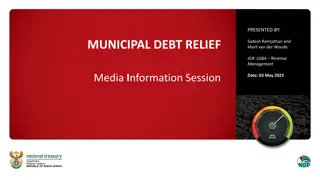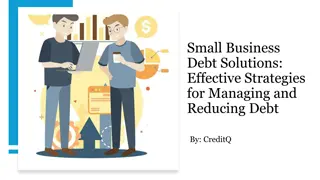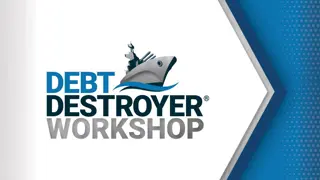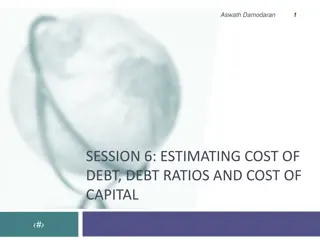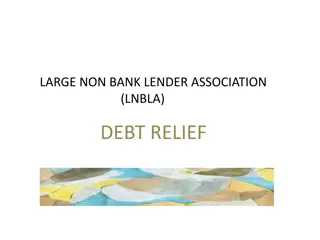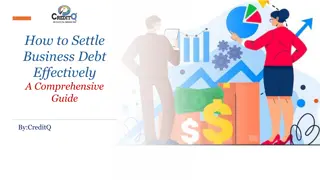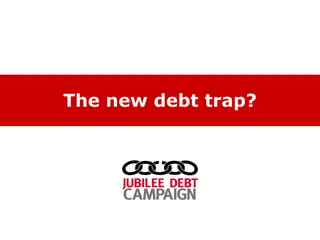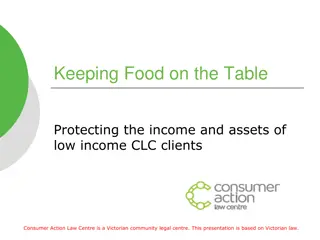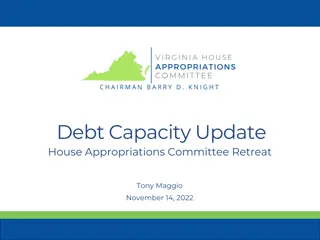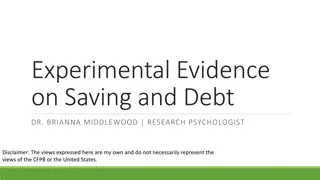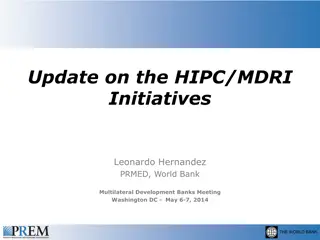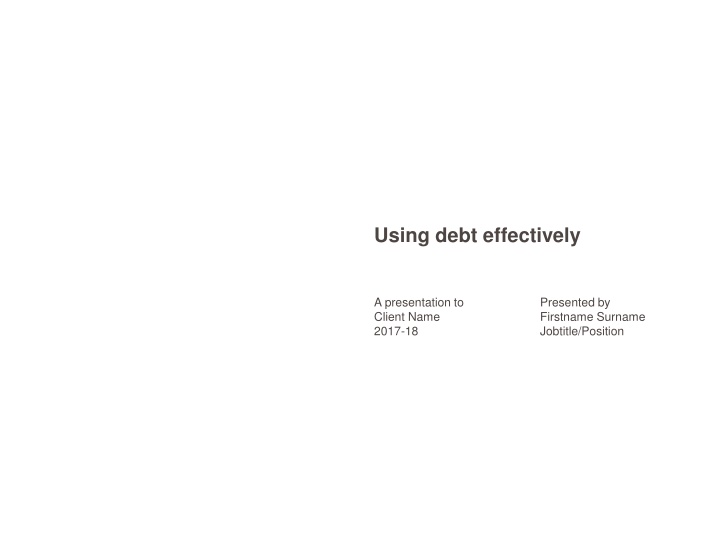
Using Debt Effectively - Key Tips for Financial Success
Explore the importance of utilizing debt effectively through a comprehensive presentation on types of debt, considerations when borrowing for a home, and more. Understand how to manage debt wisely for financial stability and growth. Advisory disclaimer included for tailored financial advice.
Download Presentation

Please find below an Image/Link to download the presentation.
The content on the website is provided AS IS for your information and personal use only. It may not be sold, licensed, or shared on other websites without obtaining consent from the author. If you encounter any issues during the download, it is possible that the publisher has removed the file from their server.
You are allowed to download the files provided on this website for personal or commercial use, subject to the condition that they are used lawfully. All files are the property of their respective owners.
The content on the website is provided AS IS for your information and personal use only. It may not be sold, licensed, or shared on other websites without obtaining consent from the author.
E N D
Presentation Transcript
Using debt effectively A presentation to Client Name 2017-18 Presented by Firstname Surname Jobtitle/Position
Important information and disclaimer This presentation has been prepared by <include appropriate adviser and licensee details from template table> This advice may not be suitable to you because it contains general advice that has not been tailored to your personal circumstances. Please seek personal financial and tax and/or legal advice prior to acting on this information. Information in this presentation is accurate as at 1 July 2017. In some cases the information has been provided to us by third parties. While it is believed the information is accurate and reliable, the accuracy of that information is not guaranteed in any way. Opinions constitute our judgement at the time of issue and are subject to change. Neither, the Licensee or any member of the NAB Group, nor their employees or directors give any warranty of accuracy, nor accept any responsibility for errors or omissions in this document. Any case studies in this presentation are for illustration purposes only. The investment returns shown in any case studies in this presentation are hypothetical examples only and do not reflect the historical or future returns of any specific financial products. Past performance is not a reliable guide to future returns as future returns may differ from and be more or less volatile than past returns. Any tax information provided in this presentation is intended as a guide only and is based on our general understanding of taxation laws. It is not intended to be a substitute for specialised taxation advice or a complete assessment of your liabilities, obligations or claim entitlements that arise, or could arise, under taxation law, and we recommend you consult with a registered tax agent. 2
Types of debt A presentation to Client Name 2017-18 Presented by Firstname Surname Jobtitle/Position
Types of debt Type Examples Could interest be tax deductible? Could asset produce income? Could asset value increase? Other comments Personal loans No No No Convenient Loans for personal consumption May provide ancillary benefits eg reward points Credit cards Highest interest rates N/A No No Yes Could use to consolidate personal consumption debt Home loans Home equity loan Yes Yes Yes An alternative is to invest in an internally geared share fund Investment loans Margin loan
Things to consider - when borrowing to buy a home A presentation to Client Name 2017-18 Presented by Firstname Surname Jobtitle/Position
Dont over-extend yourself Research shows we tend to: Be over-confident of our debt repayment ability Underestimate likelihood of things going wrong Source: Understanding human behavior in financial decision making: Some insights from behavioral economics. Paper to accompany presentation to No Interest Loans Scheme Conference Dignity in a Downturn June 2009. Ian McAuley, Centre for Policy Development and University of Canberra
Causes of mortgage stress RMIT research Looked at mortgage stress triggers Did surveys and interviews Assessed initial and final causes of missing repayments Typically more than one reason Source: Mortgage default in Australia: nature, causes and social and economic Impacts. Authored by Mike Berry, Tony Dalton and Anitra Nelson for the Australian Housing and Urban Research Institute, RMIT Research Centre, March 2010
Causes of mortgage stress Results Loss/reduced income/work Interest rates too high Too many other debts Underestimated cost of repayments Illness or accident Relationship breakdown Other 0% 10% 20% 30% 40% 50% 60% 70% Final causes Initial causes Source: Mortgage default in Australia: nature, causes and social and economic Impacts. Authored by Mike Berry, Tony Dalton and Anitra Nelson for the Australian Housing and Urban Research Institute, RMIT Research Centre, March 2010
Common new borrower mistakes Often don t understand: Range of costs, such as: mortgage insurance stamp duty solicitor/conveyancing Loan application process Ownership options joint tenants vs tenants in common The rights and obligations where loan guarantees are provided Mortgage vs offset account
Ways to reduce personal debt A presentation to Client Name 2017-18 Presented by Firstname Surname Jobtitle/Position
Ways to reduce personal debt Smart strategies may include: Consolidate debts Use cash reserve more effectively Use cashflow more effectively
Debt consolidation Why? Personal loan and credit card interest rates are generally higher By increasing your home loan and paying off these debts you could: Save on interest Pay off debts sooner Home loan Home loan Personal loan Credit card
Debt consolidation Case study background Carolyn and Ian are married with young a family Home worth $600,000 Debts Outstanding balance Interest rate Current repayments (pm) $3,153 Home loan (20 year term) $400,000 7.5% Personal Loan (5 year term) $10,000 13% $223 Credit cards $5,000 19% $72 Total $415,000 $3,448 Note: We have used a home loan interest rate of 7.5% as this is close to the historical average.
Debt consolidation Case study strategy and outcomes Increase home loan by $15,000 Pay off personal loan and credit card Make same total repayments of $3,448 into home loan Don t spend interest savings Separate loans $415,000 Consolidated loan $415,000 Outstanding loan(s) Monthly repayments $3,448 $3,448 Remaining term 18 years 4 months 17 years 11 months Total interest payments $341,596 $323,682 Interest saving $17,914 Assumptions:In both options, we ve assumed repayments of $3,448 are made for the life of the home loan. With the separate loans, payments are redirected to the home loan once the personal loan is repaid.
Use emergency cash more effectively How and why? If hold emergency cash in home loan or offset account you could: Earn higher after-tax return Reduce loan term Still access funds Higher interest rate No No No Tax Repay home loan sooner Fast access to funds effective Cash account Yes Yes Yes Yes Yes Home loan / 100% offset account
Use emergency cash more effectively Case study Background Carolyn and Ian own their home Home loan $400,000 Interest rate 7.5% pa Carolyn received $12,000 bonus Held in cash account earning 4% pa After-tax return only 2.44%1 pa 1. Assumed individual taxation of 39% (including Medicare levy). Note: We have used a home loan interest rate of 7.5% as this is close to the historical average.
Use emergency cash more effectively Case study strategy and outcomes Transfers emergency cash into 100% offset account Continues to repay $3,153 per month Before strategy After strategy Loan balance on which interest calculated Monthly home loan repayment $400,000 $388,000 $3,153 $3,153 Time taken to repay the home loan 20 years 19 years Total interest payments $355,988 $319,277 Interest saving $36,711
Use cashflow more effectively How? Strategy How it could help repay debt faster 1. Increase repayment frequency Reduces average daily loan balance even though annual repayments the same 2. Increase repayment amount Reduces loan balance sooner 3. Salary crediting Same as strategies 1 and 2, but greater effect as more money being applied against loan May achieve higher after-tax return than if salary paid into cash account Can access money to meet living expenses during month
Use cashflow more effectively Case study Carolyn and Ian owe $400,000 on their home loan Details Combined (per annum) $117,000 Ian: $2,700 After-tax salary (per fortnight) Carolyn: $1,800 Current living expenses (per month) $5,000 $60,000 Current loan repayments (per month) $3,153 $37,836 $19,164 Surplus cashflow
Use cashflow more effectively Case study Annual repayments Loan term Total interest payments $355,988 Strategy Continue paying $3,153 a month $37,836 20 years Repay $1,455 a fortnight $37,830 $327,721 19 years 2 months 18 years 8 months Increase fortnightly payments to $1,475 $38,350 $317,021 Pay 100% of salary into loan1 $57,000 9 years 10 months $157,113 Draw to pay living expenses2 1. $4,500 per fortnight. 2. $5,000 per month
Borrowing to build wealth A presentation to Client Name 2017-18 Presented by Firstname Surname Jobtitle/Position
Borrowing to build wealth When? Non-deductible debt under control Regular and secure surplus cashflow Want to achieve wealth goals sooner Prepared to take additional risks Sufficient timeframe to ride out market fluctuations Suitable insurances in place Slide 22
Borrowing to build wealth Why? Make larger investment Build wealth faster than if relying on own capital Key requirements Total return (income and growth) from investments acquired with borrowed money must exceed after-tax cost of financing investments (incl. loan interest) Quality share and property investments most suitable Have potential to grow the most in value over longer term Typically produce assessable income, so loan interest is tax deductible Slide 23
Borrowing to build wealth How? Home equity Margin loan No stamp duty Cheaper interest rate Simple instalment gearing No maximum LVR Third party security No margin call No home equity required Broader investment choice
Borrowing to build wealth Gearing case study - background Jenny has $100,000 invested in shares Earns pre-tax salary of $90,000 pa Paid off most of her home loan Wants to build wealth faster over next 10 years Considering 3 options: Maintain $100,000 investment (no gearing) Borrow $100,000 and double her existing investment (50% gearing) Borrow $200,000 and triple her existing investment (67% gearing) Slide 25
Borrowing to build wealth Gearing case study investment values after 10 years $600,000 $559,189 Earnings Borrowings $500,000 $398,320 $400,000 $300,000 $247,823 $200,000 Borrowed $200,000 Borrowings $100,000 $100,000 $0 No gearing 50% geared 67% geared Assumptions: Investment return is 9.4%pa (split 4.3%pa income 5.1%pa growth franking 77%). Interest on the loan is 7.5% pa. These rates are assumed to remain constant over the investment period. Slide 26
Borrowing to build wealth Gearing case study investment values after loan repayment $600,000 $500,000 $344,865 $400,000 $291,353 $300,000 $247,823 $200,000 $100,000 $0 No gearing 50% geared 67% geared Assumptions: Investment return is 9.4%pa (split 4.3%pa income 5.1%pa growth franking 77%). Interest on the loan is 7.5% pa. These rates are assumed to remain constant over the investment period. Slide 27
Borrowing to build wealth Types of gearing $ Excess expenses offset against income from other sources Excess income taxable Positive Neutral Negative Loan interest and other expenses Income from investments Note: This graph is for illustrative purposes only and the scale is not intended to represent any particular gearing strategy.
Borrowing to build wealth Tips and traps Gearing should be seen primarily as a wealth creation strategy rather than a way to save tax Consider and manage risks Risks Ways to manage Market declines Invest in quality assets Appropriate time horizon Discipline Rising interest rates Sufficient surplus cash flow Fix interest rates Falling investment income Sufficient surplus cash flow Loss of income due to illness/injury/death Personal insurances
Clever gearing strategies A presentation to Client Name 2017-18 Presented by Firstname Surname Jobtitle/Position
Clever gearing strategies Options include: Transform debts Recycle debts Use offset accounts effectively Maximise gearing as a couple Manage CGT
Transform your debts How it works Financial windfall ($) Investments ($) Use windfall to reduce home loan debt Borrow against increased equity for investment Investment loan Home loan Non-deductible interest Home loan Deductible interest
Transform your debts Case study - background Daniel has $200,000 home loan Marginal rate 39%1 Received $100,000 inheritance Wants to invest 1 Includes Medicare levy
Transform your debts Case study - outcomes No With transformation Home loan only transformation Home loan Loan type Investment loan $100,000 Loan amount $200,000 $100,000 Interest payable $15,000 $7,500 $7,500 Less tax deduction N/A N/A ($2,925) After-tax interest cost $15,000 $7,500 $4,575 Total after-tax interest cost $15,000 $12,075
Recycle your debts Why? Many people wait until their home loan is paid off before investing Instead, may want to increase investment debt as pay down home loan Called debt recycling Slide 35
Recycle your debts Step 1: Use some equity in home to borrow for investment Home loan Home loan Equity Equity Investment loan
Recycle your debts Step 2: Invest borrowed money Home loan Home loan Equity Equity Investments Shares Property Investment loan
Recycle your debts Step 3: Focus on paying down home loan Income from investments Home loan Tax savings from gearing Surplus cashflow Investments Shares Property Investment loan
Recycle your debts Step 4: Increase investment loan and invest more Home loan Investments Shares Property Investment loan
Recycle your debts Step 5: Continue until home loan paid off Investments Shares Property Investment loan
Recycle your debts Step 6: Make further investments Investments Shares Property Income from investments Surplus cashflow Investment loan
Recycle your debts Case study - background Greg and Jackie have home worth $600,000 and home loan of $300,000 Comfortable with debt of 67% of home (ie $400,000) Take out $100,000 interest only investment loan Invest in professionally managed share portfolio Home loan offset account: Receives investment income and surplus cashflow from investment loan interest deduction Pays investment loan interest
Recycle your debts Case study - background At the end of year 1, Greg and Jackie reduced their home loan by $40,299 They borrow an equivalent amount and invest more in their share portfolio They continue this process for the next 6 years until they repay their home loan For the next 14 years, they invest all of their surplus cashflow1in their share portfolio 1 Includes investment income and surplus cashflow from investment loan interest deduction
Recycle your debts Case study - outcomes After 20 years Debt recycling Repay home loan then invest 5 yrs 9 months Time taken to repay home loan 6 years Value of share portfolio (net of CGT) Less investment loan $2,612,423 $1,777,421 ($400,000) Nil Net position1 $2,212,423 $1,777,421 Net position after selling ALL investments, paying CGT and repaying loan $435,002 Assumptions: The return on the share portfolio is 9.4% pa (split 4.3% income and 5.1% growth). The franking level on income is 77%. The interest rate applying to the home loan and investment loan is 7.5% pa. These rates are assumed to remain constant over the investment period. Greg earns a salary of $108,000 pa and Jackie earns $51,000. 1 Includes investment income and tax savings
Use offset accounts effectively What are offset accounts? Cash accounts Attached to home or investment loan Balance offsets loan amount Reduces interest payable on loan Can access funds at any time
Use offset accounts effectively Case study 1 Background Sally has a principal residence Original loan $200,000 Has paid $100,000 into offset account Wants to invest $100,000
Use offset accounts effectively Case study 1 Option 1: Draw from offset account for investment Existing loan unchanged Purpose: Non-investment Outcome: Interest non-deductible Outstanding loan $200,000 Offset account $100,000 Draw for investment Not a new loan After paying $100,000
Use offset accounts effectively Case study 1 Option 2: Use cash in offset account to reduce home loan Outstanding loan $200,000 $100,000 Equity $100,000 Offset account $100,000
Use offset accounts effectively Case study 1 Option 2: Take out separate investment loan Outstanding loan $200,000 $100,000 Existing loan reduced Purpose: Non-investment Outcome: Interest non-deductible Equity $100,000 Investment loan $100,000 New investment loan Purpose: Investment Outcome: Interest deductible
Use offset accounts effectively Case study 2 Background Rob has a home Original loan $200,000 Has repaid $100,000 Wants to use equity of $100,000 as a deposit to purchase a new principal residence Current home to become investment property


